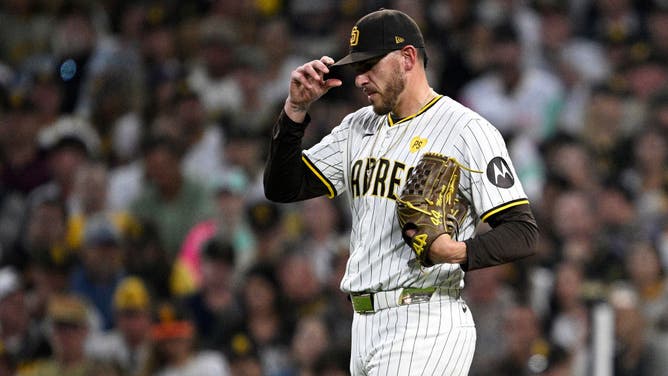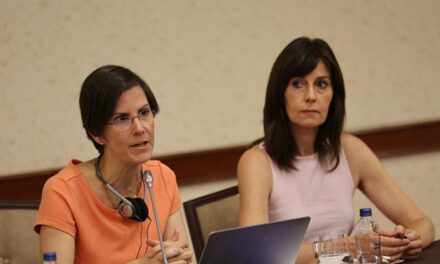We support our Publishers and Content Creators. You can view this story on their website by CLICKING HERE.
The San Diego Padres advanced to the National League Division Series on Wednesday night after a 5-4 win over the Atlanta Braves. It was a microcosm of the second half of the Padres 2024 season; quality starting pitching, bullpen depth, good fortune and timely situational hitting. It also took away San Diego’s biggest advantage over other playoff teams, including their NLDS opponents, the Los Angeles Dodgers.
The Padres scored all five of their runs in the second inning, putting together a two-out rally against Braves starter Max Fried. Luis Arraez singled following a game-tying Kyle Higashioka home run, then Fernando Tatis Jr. tapped a ball to third that resulted in an infield single. Jurickson Profar added an even more weakly hit infielder grounder, loading the bases for Manny Machado. Machado doubled in two, and Jackson Merrill followed with a bases-clearing triple to push the lead to 5-1.
Padres starter Joe Musgrove then settled in after a shaky first inning, retiring eight Braves in a row into the 4th. But the game and San Diego’s future prognosis rapidly changed with Musgrove facing Braves star Marcell Ozuna. Higashioka and the Padres bench noticed that Musgrove’s velocity dropped several miles per hour, both on his fastball and curveball. And after a visit from the training staff, Musgrove left the game. And in the process, took away the team’s biggest advantage moving forward.

SAN DIEGO, CALIFORNIA – OCTOBER 02: Joe Musgrove #44 of the San Diego Padres adjusts his hat against the Atlanta Braves during the fourth inning in Game Two of the Wild Card Series at Petco Park on October 02, 2024 in San Diego, California. (Photo by Orlando Ramirez/Getty Images)
Padres Pitching Depth Will Now Be Tested Heading Into The NLDS
The Padres lineup has depth and quality, headlined by Machado, Tatis, Merrill and Xander Bogaerts. Luis Arraez rarely strikes out, Profar is coming off the best season of his career, and Higashioka unexpectedly has one of the highest home run per at bat rates this year. While their second half hitting has been exceptional, outside of Merill and Machado, the team’s defense is lacking.
Defensively, San Diego ranked just 20th in Major League Baseball in added run value, per Fangraphs. Other advanced defensive metrics, including UZR, ranked the team even lower. Overall though, the Padres lineup, even including its mediocre defense and baserunning, is solidly above average. But their real strength entering October was pitching. Particularly starting pitching.
In an era with more pitcher injuries than ever, San Diego started the wild card series with a completely healthy starting staff. Michael King, Dylan Cease, Joe Musgrove and Yu Darvish gave the Padres four options to rely on for both length and quality. But Musgrove’s injury, described by the team as “right elbow tightness,” immediately changed that prognosis moving forward.
Cease and King remain two of the best pitchers in the National League, and Darvish has generally pitched well since returning from a long absence. But assuming that Musgrove is done for the playoffs, a near certainty given an elbow injury, the Padres will now be forced to turn to a much less appealing option in a potential and pivotal NLDS game four. Instead of Musgrove or Darvish, San Diego will have to turn to a bullpen game or risk starting Martin Perez or Randy Vazquez against a fearsome Dodgers lineup.
Perez was brutal in 2024, with a 5.38 expected ERA and 4.90 FIP. Vazquez was arguably even worse. He posted a 4.87 ERA and 5.89 expected ERA, with just 5.6 strikeouts per nine innings. That vaunted Padres pitching staff got a lot thinner when Musgrove walked off the mound.
Even a closer look at Darvish’s 2024 reveals plenty to be worried about. His hard hit rate allowed is the highest of his career, by a wide margin. His average fastball velocity is down half a mile an hour from 2023, his FIP is the highest of his career, thanks to a career low strikeout rate. And his average exit velocity allowed is also up to 89.4, another career high, from 88.4 in 2023. He’d still be one of the postseason’s best game four starters. But in game three, those numbers start to look a lot more concerning.
San Diego still has one of the postseason’s best bullpens, though closer Robert Suarez struggled badly in September and set up man Jason Adam has now allowed four runs in his last 5.2 innings. With Musgrove out, those relievers, who were already heavily used in August and September, will now be forced to take down even more innings. That doesn’t mean they can’t or won’t be successful, and the Padres are still only slight underdogs against the Dodgers, but the margin for error just got a whole lot smaller.

 Conservative
Conservative  Search
Search Trending
Trending Current News
Current News 





